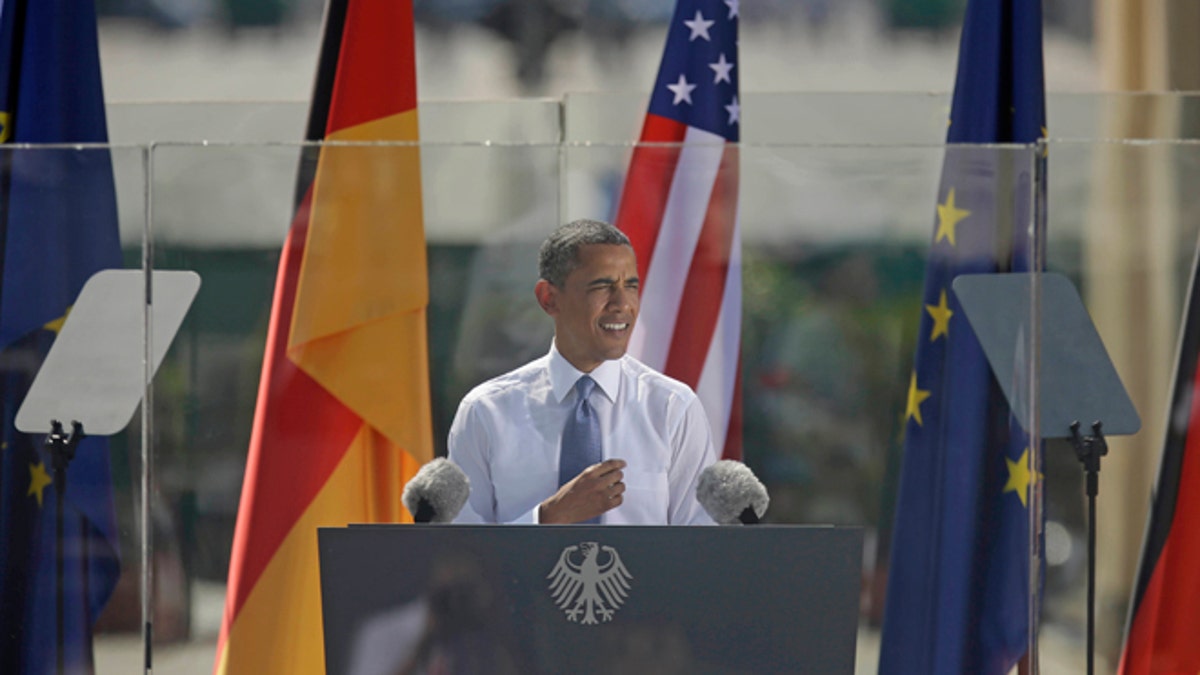
June 19, 2013: President Obama speaks in front of the iconic Brandenburg Gate in Berlin, Germany. (AP)
For nearly 40 years, the Soviet Union and the United States sat on the precipice of mutually assured destruction. Through luck and carefully crafted negotiations, both sides were able to avoid unleashing a wave of destruction that would end life as we know it.
Today, however the threat of a nuclear conflict between the major powers is practically nil. Obama’s June 19 speech in Berlin was merely a smoke-and-mirrors performance. After failing to come to terms with President Putin over Syria at the G8 Summit in Belfast, he has gone for the low hanging fruit―strategic arms reductions.
Nuclear weapons are the white elephants of the American military industrial complex.
Estimates by Global Zero in 2011 put America’s spending and servicing on its nuclear arsenal at $61.3 billion―more than all other nuclear powers combined, and more than four times what Russia spends on its arsenal.
[pullquote]
At a time of budget sequestration, the United States could indeed unilaterally cut its arsenal by one-third, as Obama proposed, thereby saving taxpayers billions while maintaining its deterrent power.
The fact that Obama announced this new proposal in Berlin merely demonstrates his inability to accomplish anything truly meaningful with his Russian counterparts.
Increasing anti-American rhetoric from the Kremlin, along with its continued support of the Assad regime, shows that this administration is mishandling its negotiations with Russia.
If the administration’s last performance on nuclear negotiations with Russia is anything to go by, it is likely that this new proposal will not mention the issue of tactical nuclear weapons.
At current count, Russia has more than 3,000 tactical nuclear weapons. Pockets of secrecy continue to obscure the actual number.
These are the weapons that the president should be most concerned about. These battlefield nukes― highly mobile and of limited destructive capacity―could unleash massive damage if they were to fall into the wrong hands.
Given Russia’s track record on arms sales and its failure to keep track of all its stockpiles, these weapons are a genuine menace to the international system.
In the hands of terrorist or rogue states, these weapons could inflict massive amounts of damage, yet they are small enough that their deployment would not necessarily trigger the mutually assured destruction switch.
Russia, which has been playing an increasingly adversarial role against the United States, is not likely to budge on this issue. Russia’s conventional forces are far weaker, and therefore the tactical nukes help buttress its fighting power.
Obama’s renewed attempt at strategic arms reduction should not be heralded as a real victory.
The conflict in Syria continues to rage, with Russia and Iran supporting the Assad regime. Putin remains as anti-American as ever.
Rather, Obama’s proposal should be seen as an attempt by the administration to mask its ineptitude in dealing with adversarial states.
The Obama administration needs to change tactics if it is to achieve a more just, peaceful and environmentally safe world. Hiding behind strategic arms reductions does nothing to stop the fighting in Syria or the unrest elsewhere in the world.
In terms of foreign relations, Obama is a Potemkin president.
